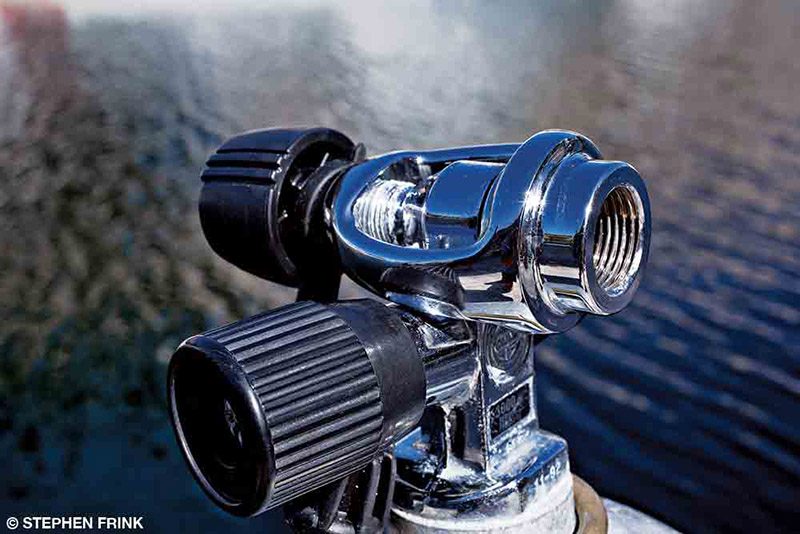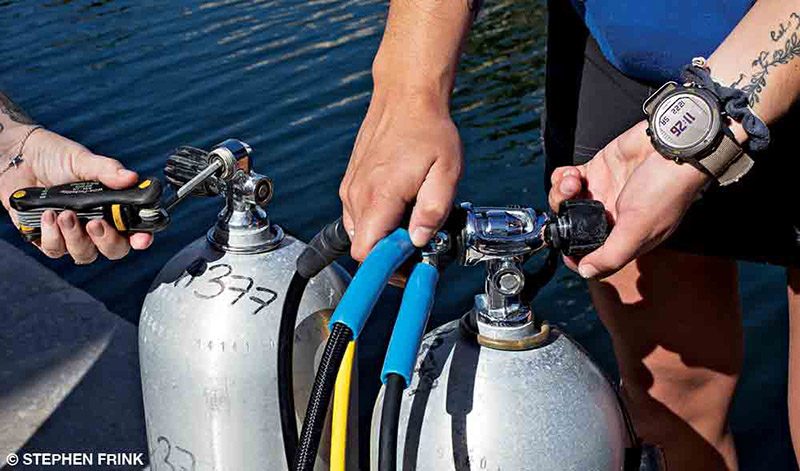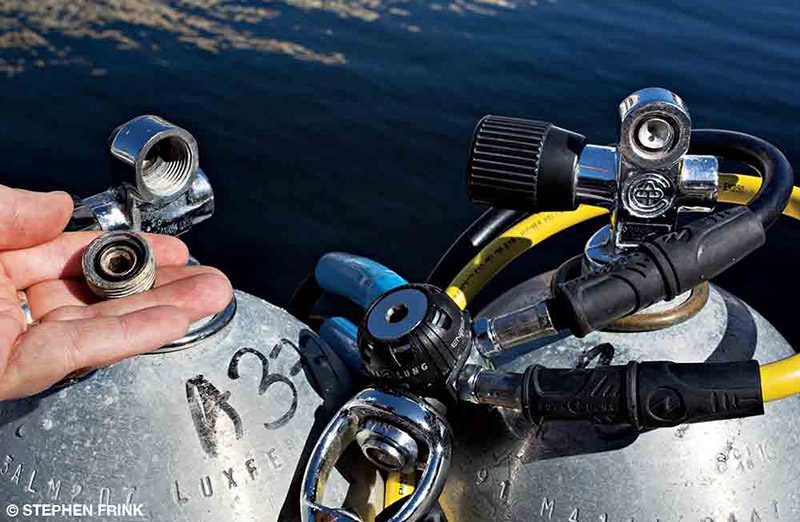Sitting in your open-water classroom and looking out the window, you might have seen palm trees swaying in the wind, snowflakes falling to the ground or the glare of a hundred windshields in a hot, suburban parking lot. Classroom views can vary, but one thing that looks the same in almost every open-water class taught in the United States is the tank valve. K-valves with yoke attachment points are the most commonly used valves in recreational scuba diving in the U.S., Mexico, Australia, Southeast Asia and much of the Caribbean. In some parts of the world, however, DIN (for Deutsches Institut für Normung, a German standards organization) valves predominate. Both types of valves have benefits, and there are adapters for both, but understanding how these valves work may help keep you blowing bubbles rather than watching them.
Yoke attachments make gear setup and breakdown a breeze: All you have to do is place the yoke over the tank valve and tighten it into place. Their ease of use makes learning frustration-free, especially for children and divers with smaller hands. K-valves are also resilient to the types of dents that render DIN valves unusable, making them a popular choice for charter operators who get a lot of use out of their cylinders.

Among recreational divers, the biggest gripe about yoke attachment points are the external O-rings. Since the O-rings on K-valves are constantly exposed to the elements and general wear and tear, they are prone to cracking or extruding, which can compromise the seal between the first stage and the tank valve, allowing air to escape. Sometimes air escapes as a tiny stream of bubbles, but if an O-ring is completely obliterated, lots of air can escape very quickly, shortening a dive or ending it before you even hit the water. To mitigate this risk, dive operators often carry several replacement O-rings in their save-a-dive kits. Despite this minor inconvenience, yoke valves are extremely functional and are safe for use in any recreational context.
If you dive in Europe, you are probably familiar with DIN valves, but even if you don’t know about them, you may become familiar soon. Like the American National Standards Institute (ANSI) in the U.S., DIN standardizes everything in Germany from the physical properties of toothbrushes, to the requirements for Braille on packaging, to the diameter and thread count of screw-in regulator attachments. Some people may assume DIN valves are German engineering at its finest, but DIN valves were invented in the United States in the late 1950s. These valves were pushed to the sidelines in recreational diving, but due to their pressure resilience DIN valves became standard for technical and commercial diving in which high-pressure tanks are commonly used. But like other dive equipment such as backplate-and-wing buoyancy compensators, DIN attachments are no longer reserved exclusively for technical diving and are making their mark in the recreational world.
Threaded DIN attachments are male connectors that screw directly into the female tank valves, and their captured O-rings are often spared from undue exposure and wear and tear. DIN valves also have a much higher pressure capacity than K-valves and come in two varieties: 200 bar and 300 bar.

The 200-bar DIN valves are designed for cylinders with test pressure ratings of up to 300 bar, which is 4,351 pounds per square inch (psi). The working pressure of the corresponding cylinders is about 200 bar (2,900 psi), which is essentially the same working pressure of K-valves (3,000 psi). DIN-to-yoke adapter inserts are compatible only with 200-bar DIN valves because their working pressure is similar to that of K-valves.
The 300-bar DIN valves are designed for high-pressure cylinders with test pressure ratings of up to 450 bar (6,527 psi) and working pressures of about 300 bar (4,351 psi). The main difference between the two types of DIN valves is the thread count, which is deliberately different to prevent a diver from seating a 200-bar DIN connector to a 300-bar valve. Connecting a 300-bar connector to a 200-bar DIN valve, however, should present no issue and may be even easier because fewer turns are required to seat the regulator. Because 200-bar DIN valves are compatible with both 200-bar and 300-bar connectors, they are the most commonly used DIN valves and the ones most likely seen in recreational diving.
How Do I Choose?
In the past, DIN valves and connectors were much sturdier than K-valves and yoke attachments. They were also much more expensive. With advanced technology, both types of valves and connectors have improved significantly over time, and today their prices are comparable. In the absence of these differences between the valves and connectors, choosing your setup is largely a matter of personal preference.
Some divers enjoy the ease of use and popularity of yoke attachments, appreciating their convenience and availability at nearly every dive destination. If traveling somewhere partial to DIN valves, all they need to make their regulator compatible is an affordable DIN-to-yoke adapter.

Other divers prefer the security of DIN valves and enjoy the flexibility they allow. With DIN valves, divers can explore realms beyond recreational diving without breaking the bank by purchasing a single regulator to use for recreational dives, technical dives or cave dives if they wish to advance their training. Today many recreational divers exclusively use DIN valves, claiming they break less often and last longer than yoke attachments. O-ring extrusion is not a chronic issue with DIN valves, and there is almost no room for confusion with orientation when attaching a regulator to a DIN valve. Many divers also believe DIN valves are safer since they have been historically crafted to withstand high pressures, and some believe they will hold up better in an overpressurization event. If divers with DIN regulators travel to places without DIN valves, they can use a yoke-to-DIN adapter or, in some cases, a hex key or Allen wrench to remove the yoke insert and screw their DIN connector directly into the tank valve.
Pick the valve or connector that best suits your diving lifestyle, and always stay within your limits: Equipment is no substitute for training. After doing your own research and deciding what you want out of your equipment, try it on: Assemble, dive and disassemble regulators with DIN attachments and yoke attachment points to see which you prefer. Once you make your decision, get an adapter so you can always be ready to put your head underwater.
© Alert Diver — Q1 2019